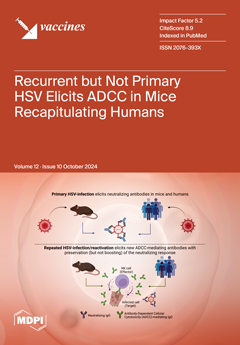Background/Objectives: Vaccines may improve the control and eradication of bovine tuberculosis. However, the evaluation of experimental candidates requires the assessment of the protection, excretion, transmission and biosafety. A natural transmission trial among likely infected animals was conducted.
Methods: Seventy-four male heifers
[...] Read more.
Background/Objectives: Vaccines may improve the control and eradication of bovine tuberculosis. However, the evaluation of experimental candidates requires the assessment of the protection, excretion, transmission and biosafety. A natural transmission trial among likely infected animals was conducted.
Methods: Seventy-four male heifers were randomly distributed (five groups) and vaccinated subcutaneously with attenuated strains (
M. bovis Δmce2 or
M. bovis Δmce2-
phoP), a recombinant
M. bovis BCG Pasteur (BCGr) or
M. bovis BCG Pasteur. Then, they cohoused with a naturally infected bTB cohort under field conditions exposed to the infection.
Results: A 23% of transmission of wild-type strains was confirmed (non-vaccinated group). Strikingly, first vaccination did not induce immune response (caudal fold test and IFN-gamma release assay). However, after 74 days of exposure to bTB, animals were re-vaccinated. Although their sensitization increased throughout the trial, the vaccines did not confer significant protection, when compared to the non-vaccinated group, as demonstrated by pathology progression of lesions and confirmatory tools. Besides, the likelihood of acquiring the infection was similar in all groups compared to the non-vaccinated group (
p > 0.076). Respiratory and digestive excretion of viable vaccine candidates was undetectable. To note, the group vaccinated with
M. bovis Δmce2-phoP exhibited the highest proportion of animals without macroscopic lesions, compared to the one vaccinated with BCG, although this was not statistically supported.
Conclusions: This highlights that further evaluation of these vaccines would not guarantee better protection. The limitations detected during the trial are discussed regarding the transmission rate of
M. bovis wild-type, the imperfect test for studying sensitization, the need for a DIVA diagnosis and management conditions of the trials performed under routine husbandry conditions. Re-vaccination of likely infected bovines did not highlight a conclusive result, even suggesting a detrimental effect on those vaccinated with
M. bovis BCG.
Full article






